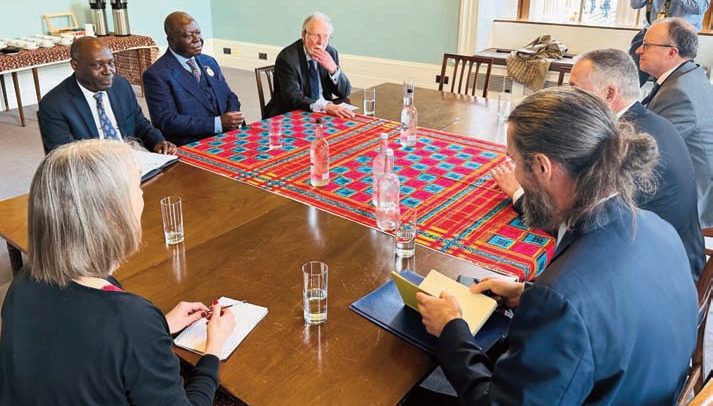Otumfuo with his two technical advisors – Ivor Agyeman-Duah and Malcolm McLeod and the leadership of the British Museum
The Asantehene, Otumfuo Osei Tutu II, has ramped up negotiations for the possible repatriation of Ashanti regalia artifacts seized from Kumasi by the British army after the Ashanti-British war in 1874, popularly known as the Battle of Amoaful.
Last Thursday, the king held discussions with the leadership of the British Museum (BM) in London on the matter.
German art historian Dr. Hartwig Fischer, the director of the BM; Dr. Jonathan Williams, the deputy director; Sam Nixon, Head of Africa Department and Curator; and Julie Hudson were all present at the crucial meeting.
The British Museum houses a collection of treasures, including those captured from the Asantehene’s palace during the war.
At the time, Otumfuo also requested contemporary cultural cooperation in management and technical support with the Manhyia Palace Museum.
Ivor Agyeman-Duah, an Asantehene co-advisor on technical matters relating to the repatriation of the treasures, explained what happened at the meeting, saying the British Museum agreed to study and work on a technical framework by two advisors of the Asantehene.
Mr. Agyeman-Duah, a historian, museum economist, and development specialist, added that an expired memorandum of understanding (MoU) of collaboration between the Manhyia Palace and the British Museum would be reviewed, with a loaning agreement reached for some of the items to be sent to Kumasi for the Asantehene’s silver jubilee next year.
He said Otumfuo stressed the need for these regalia artifacts to be returned home and asked his hosts to consider these wishes, notwithstanding the laws of antiquity in Britain, noting that there has been a long-time negotiation for this.
He indicated further that the Asantehene took the opportunity to explain that the Manhyia Museum was going through a significant expansion and restructure because it is a living, profitable museum.
For the king, the Manhyia Museum, like all major museums, needed other collections to occasionally strengthen patronage and growth, adding that this ought to be considered despite antiquity laws in Britain.
The other advisor on the technical matters, Malcolm McLeod, is a former Keeper of Ethnography at the museum and previously Professor of History and Vice Principal of the University of Glasgow.
Dr. Fischer, who led the BM team in discussions, described the Asante King’s visit as an important one and indicated that the Asantehene’s wishes would be carried out in line with the structured laws of the British people.
Dr. Fischer was instrumental in the founding of the Manhyia Palace Museum in 1994.
The technical discussions, which began last week in London, would also result in visits to the Manhyia Palace Museum, object identification at the British Museum for loan agreements, and other legal ramifications, because the British Museum Act does not permit permanent removal of items from its collection.
The British Museum, led by Dr. Fischer, would also be involved in the reopening and anniversary of the Manhyia Palace Museum.
Mr. Agyeman-Duah was also scheduled to meet with Dr. Tristram Hunt of the Victoria and Albert Museum (V&A), the world’s leading art and design institution, on behalf of the Manhyia Palace.
Manhyia and V&A would execute a bilateral agreement with the Palace before February 2024.
The V&A, which also possesses a collection of Asante regalia, is planning a programme to commemorate the 150th anniversary of the 1874 Anglo-Asante War in February 2024.
A group of Ghanaian and British artists would work together to create a memorial in London.
Next year will also mark the 100th anniversary of Asantehene Agyeman Prempeh I’s return from exile in the Seychelles, where he spent 27 years.
Background
Dr. Hunt hinted at the likely return of Asante regalia in the V&A museum’s annual evaluation for 2021-2022.
“We are optimistic that a new partnership model can forge a potential pathway for these important artefacts to be on display in Ghana in the coming years,” he wrote.
By Ernest Kofi Adu


